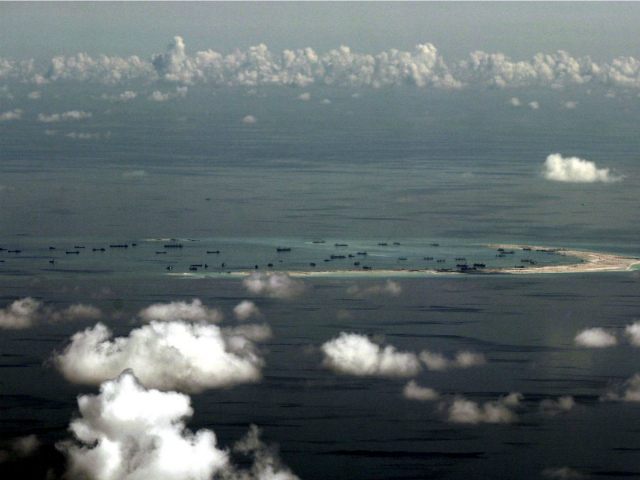Vietnam has invested in an expanded airplane runway in the Spratly Islands, a disputed chain in the South China Sea, that would grant it greater flexibility in defending its assets in the region from an increasingly belligerent China.
The Center for Strategic and International Studies (CSIS) published satellite images last week of Spratly Island, the flagship island in the chain, that appear to indicate Vietnam is modifying its assets there to allow easier access for some new defense aircraft.
“Vietnam has lengthened the runway at Spratly Island from less than 2,500 feet (the shortest of any claimants’ in the Spratlys) to about 3,300 feet,” CSIS noted. “These new facilities can easily accommodate the Vietnamese air force’s PZL M28B maritime surveillance aircraft and CASA C-295 transport planes.” Expanding these runways requires the dredging of land to make the island larger, a process similar to what China has done in disputed shoals to convert reefs into complete islands.
The Associated Press reports that China nearly immediately responded to the CSIS report demanding that Vietnam cease developing its territory. “China’s Foreign Ministry spokesman Geng Shuang on Friday demanded Vietnam stop construction ‘on China’s territory,'” the AP notes. The expanded runways follow reports last August that Vietnam had begun deploying rocket launchers to its bases in the Spratly Islands, though the Vietnamese Foreign Ministry called the report inaccurate. Due to China’s persistence in usurping foreign territory in the South China Sea, it is unlikely Vietnam will heed China’s demand it stop constructing facilities on the Spratly Islands.
Beijing claims the Spratly and Paracel Islands in the South China Sea, as well as the Scarborough Shoal and other pivotal territories in the sea. The “nine-dash line” China claims as its maritime border deprives Vietnam, Malaysia, Brunei, Taiwan, the Philippines, and Indonesia of its territory. China insists on building military and civilian surveillance facilities in this territory despite losing a case on the matter in international court last July, a case China vowed to ignore as American and Japanese meddling.
While China and Vietnam are both communist nations, their bilateral relationship has soured in light of China’s attempts to colonize Vietnamese territory. Vietnam has thus turned to the West, particularly Japan and the United States, for help in protecting its territory from its larger neighbor. Meeting during this weekend’s Asia Pacific Economic Cooperation (APEC) conference, Japanese Prime Minister Shinzo Abe and Vietnamese President Tran Dai Quang agreed to deepen bilateral cooperation, just as Chinese President Xi Jinping urged those wronged by Beijing’s South China Sea stance not to support each other.
Xi, Reuters reports, urged Tran and Philippines President Rodrigo Duterte to work to resolve the South China Sea disputes “bilaterally,” in what the newswire service describes as a “divide and conquer” tactic meant to weaken international resolve against the Chinese communists’ belligerence.
Xi’s approach has worked better with Duterte than with Tran, who has reportedly agreed to prevent Philippines fishermen from legally fishing in their own waters.
In addition to Vietnam strengthening its presence in the Spratly Islands, Xi may soon have to contend with a challenge from within “China” itself: Taiwan, now governed by pro-independence president Tsai Ing-Wen, has planned what Voice of America calls “an unusual military drill in the contested South China Sea.” China has traditionally reported any attempts by Taiwan to assert its claims in the South China Sea as supportive of China’s claims, as it rejects Taiwan’s sovereignty, though this may be complicated by Tsai’s rise to power.

COMMENTS
Please let us know if you're having issues with commenting.